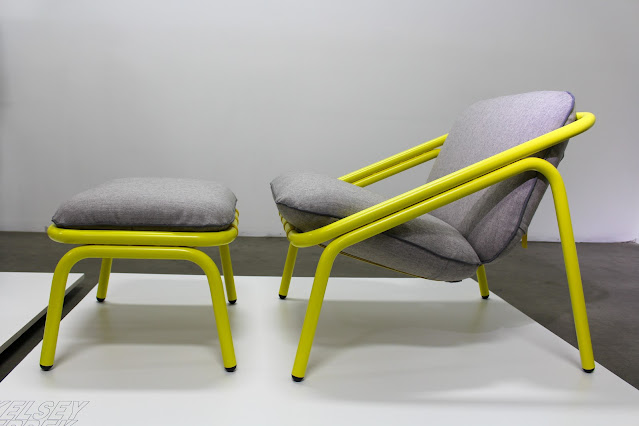The Successful Design Business Practices of Walter Dorwin Teague: part 3
Part 3 of 5: Office Atmosphere and Building Alliances with Clients
(click here for part 1 and part 2)
 |
| Figure 1: Teague drafting room, New York City, circa 1938. photo by Stowe Myers. |
Office Atmosphere
How did Teague run his office? What was it like to work at WDTA during its heyday? In 16mm film shot by partner, Stowe Myers, the 1940’s staff of Teague is shown at work and at play in their New York office studio. Drafting desks are arranged in two long rows, all facing the front of the room, where the most senior designer or architect would be working. The film also shows office parties, which included drinks and group singing. It also documents a casual office art exhibition, where staff could display their personal artistic works, painting, drawing, and watercolors. Although everyone worked rigorously, he allowed occasions for staff to celebrate their hard work and talents with parties and other creative events. Stowe Myers who worked there from 1934 to 1952 said:
“Both offices [Loewy’s and Teague’s] engendered certain camaraderie of the personal and a general ambiance that was more likely I think in the 50s and maybe less evident today. There were Christmas parties and sometimes birthday parties and then there were the four martini lunches, so to speak. They were common place. It was all in line with the pressures of advertising agencies are noted for, and because so many of them were on that street, Madison Avenue..” - (Myers)
 |
| Figure 2: Teague joking around during an office party 1938. Photo Stowe Myers. |
Senior Product designer, Gifford Jackson, who worked there from 1954 to 65, writes:
"The office in New York was well run and business like. There was a certain underlying discipline, but it was a pleasant place in which to work. The partners were very gentlemanly and Mr. Teague, although in photos sometimes looked as though he could be stern and tough, was very nice to confer with. He certainly was very good to me. In general, there was a good feeling between the designers in the "bull-pen" (referring to the booth-like spaces we worked in). Many of us made friends there which lasted many years." (Jackson)
I just finished editing this video showing the designers and architects of Walter Dorwin Teague's New York office in 1940. Shot by C. Stowe Myers and provided by his son Charlie Myers.
In 1945, Teague changed his corporate structure from a sole-proprietorship to a partnership, in which he selected a few of his most senior staff to be partners in the company. This allowed them to participate in profit-sharing and allowed Teague to delegate greater responsibilities, especially considering the growth of his business. This also increased employee retention and pride in ownership in the company and encouraged the project’s success.
Building Alliances
Teague’s son, Dorwin, worked with his father for many years and writes this about their strategy for business development:
“Much of the success of a particular assignment depended upon the personality of our contact in the client’s organization. This was usually the chairman, president or the chief executive officer. His attitude would be reflected by the engineering and marketing personnel and could range from enthusiastic cooperation to suspicion and outright hostility. In the early years, cheerful acceptance of the designer’s contribution was the norm; later on we would occasionally run into antagonism. In most cases I was able to convince the engineering people that I was sincerely trying to work with them and was not threatening their jobs. Nothing infuriates an engineer more than to have some outsider second-guess a product that is the result of years of hard work on his part. But if he can be persuaded that a better final result will be achieved, and that he will receive at least part of the credit for the improvement, an atmosphere of mutual respect and cooperation develops, which guarantees successful conclusion.”
 |
| The Dupont Pavilion at the 1939 World's Fair in New York. Designed by Teague and staff. Photo by Stowe Myers. |
In later years one member of our organization, the account executive on some large accounts, would deal strictly with the person in charge of the client’s organization. He determined first what this individual was expecting and then slanted the design in that direction.” (Teague, W.D. Jr. 48)
Teague’s strategy was to form an alliance with the top leadership within the client’s organization. He would learn about the goals and objectives of the senior decision maker, CEO, President, or owner, and become their advocate and supporter. He also established an alliance with the client’s staff, assuring them that the relationship would not be antagonistic, but rather mutually benefitial. Teague knew that business is about relationships. He developed lasting, close relationship with key people in the client’s company.
Coming up next in part 4: Teague proclaims his disdain of marketing and surveys
Follow the progress of the Teague documentary on Facebook and this blog.
Works Cited
Jackson, Gifford. Letter to Prof. Jason A. Morris. 29 Sept. 2010. Print
Myers, Stowe. "Living Legend of Industrial Design: Stowe Myers." Living Legends Meeting, Association of Professional Design Firms. Whitehall Hotel, Chicago. 5 June 1987. Speech, Audio Recording.
Teague, W. Dorwin Jr. Industrial Designer: the Artist as Engineer. Lancaster, PA: Armstrong World Industries, 1998. Print.



Comments